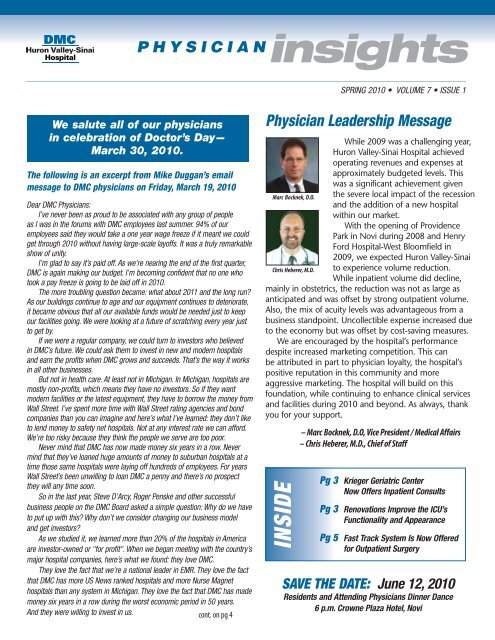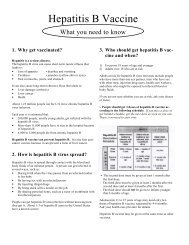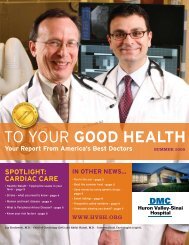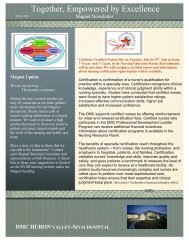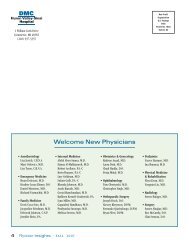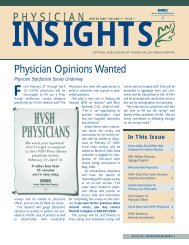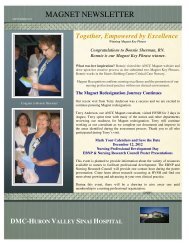Spring 2010 Physician Newsletter - Huron Valley-Sinai Hospital
Spring 2010 Physician Newsletter - Huron Valley-Sinai Hospital
Spring 2010 Physician Newsletter - Huron Valley-Sinai Hospital
You also want an ePaper? Increase the reach of your titles
YUMPU automatically turns print PDFs into web optimized ePapers that Google loves.
P H Y S I C I A N insightssPRinG <strong>2010</strong> • VOLUME 7 • issUE 1We salute all of our physiciansin celebration of Doctor’s Day—March 30, <strong>2010</strong>.The following is an excerpt from Mike Duggan’s emailmessage to DMC physicians on Friday, March 19, <strong>2010</strong>Dear DMc <strong>Physician</strong>s:i’ve never been as proud to be associated with any group of peopleas i was in the forums with DMc employees last summer. 94% of ouremployees said they would take a one year wage freeze if it meant we couldget through <strong>2010</strong> without having large-scale layoffs. it was a truly remarkableshow of unity.i’m glad to say it’s paid off. as we’re nearing the end of the first quarter,DMc is again making our budget. i’m becoming confident that no one whotook a pay freeze is going to be laid off in <strong>2010</strong>.The more troubling question became: what about 2011 and the long run?as our buildings continue to age and our equipment continues to deteriorate,it became obvious that all our available funds would be needed just to keepour facilities going. We were looking at a future of scratching every year justto get by.if we were a regular company, we could turn to investors who believedin DMc’s future. We could ask them to invest in new and modern hospitalsand earn the profits when DMc grows and succeeds. That’s the way it worksin all other businesses.But not in health care. at least not in Michigan. in Michigan, hospitals aremostly non-profits, which means they have no investors. so if they wantmodern facilities or the latest equipment, they have to borrow the money fromWall street. i’ve spent more time with Wall street rating agencies and bondcompanies than you can imagine and here’s what i’ve learned: they don’t liketo lend money to safety net hospitals. not at any interest rate we can afford.We’re too risky because they think the people we serve are too poor.never mind that DMc has now made money six years in a row. nevermind that they’ve loaned huge amounts of money to suburban hospitals at atime those same hospitals were laying off hundreds of employees. For yearsWall street’s been unwilling to loan DMc a penny and there’s no prospectthey will any time soon.so in the last year, steve D’arcy, Roger Penske and other successfulbusiness people on the DMc Board asked a simple question: Why do we haveto put up with this? Why don’t we consider changing our business modeland get investors?as we studied it, we learned more than 20% of the hospitals in americaare investor-owned or "for profit". When we began meeting with the country’smajor hospital companies, here’s what we found: they love DMc.They love the fact that we’re a national leader in EMR. They love the factthat DMc has more Us news ranked hospitals and more nurse Magnethospitals than any system in Michigan. They love the fact that DMc has mademoney six years in a row during the worst economic period in 50 years.and they were willing to invest in us.cont. on pg 4<strong>Physician</strong> Leadership MessageWhile 2009 was a challenging year,<strong>Huron</strong> <strong>Valley</strong>-<strong>Sinai</strong> <strong>Hospital</strong> achievedoperating revenues and expenses atapproximately budgeted levels. Thiswas a significant achievement givenMarc Bocknek, D.O. the severe local impact of the recessionand the addition of a new hospitalwithin our market.With the opening of ProvidencePark in Novi during 2008 and HenryFord <strong>Hospital</strong>-West Bloomfield in2009, we expected <strong>Huron</strong> <strong>Valley</strong>-<strong>Sinai</strong>Chris Heberer, M.D. to experience volume reduction.While inpatient volume did decline,mainly in obstetrics, the reduction was not as large asanticipated and was offset by strong outpatient volume.Also, the mix of acuity levels was advantageous from abusiness standpoint. Uncollectible expense increased dueto the economy but was offset by cost-saving measures.We are encouraged by the hospital’s performancedespite increased marketing competition. This canbe attributed in part to physician loyalty, the hospital’spositive reputation in this community and moreaggressive marketing. The hospital will build on thisfoundation, while continuing to enhance clinical servicesand facilities during <strong>2010</strong> and beyond. As always, thankyou for your support.INSIDE– Marc Bocknek, D.O, Vice President / Medical Affairs– Chris Heberer, M.D., Chief of StaffPg 3 Krieger Geriatric CenterNow Offers Inpatient ConsultsPg 3 Renovations Improve the ICU’sFunctionality and AppearancePg 5 Fast Track System Is Now Offeredfor Outpatient SurgerySAVE THE DATE: June 12, <strong>2010</strong>Residents and Attending <strong>Physician</strong>s Dinner Dance6 p.m. Crowne Plaza Hotel, Novi
CLINICAL QUALITY<strong>Huron</strong> <strong>Valley</strong>-<strong>Sinai</strong> Rates Highly in Infection Control<strong>Huron</strong> <strong>Valley</strong>-<strong>Sinai</strong> <strong>Hospital</strong> has received favorablenational and local media coverage as one of six Michiganhospitals to eliminate central line infections during the pasttwo years. This effort to reduce infections was begun by theLeapfrog Group, an association of major national employersand health researchers at Johns Hopkins University, and ledin Michigan by the Michigan Health and <strong>Hospital</strong>Association. Reporting hospitals were required to have aminimum of 1,000 central line days; <strong>Huron</strong> <strong>Valley</strong>-<strong>Sinai</strong> had2,268 central line days during the time period reported.Among the 25 southeast Michigan hospitals reportingdata, <strong>Huron</strong> <strong>Valley</strong>-<strong>Sinai</strong> <strong>Hospital</strong> was one of only three toeliminate central line infections during the two-year period.James Gordon, M.D., chief of infectious diseases at <strong>Huron</strong><strong>Valley</strong>-<strong>Sinai</strong> <strong>Hospital</strong> and assistant professor of clinicalmedicine at Wayne State University School of Medicine, wasinterviewed in a Consumer Reports article about the Leapfrogstudy results. He credits <strong>Huron</strong> <strong>Valley</strong>-<strong>Sinai</strong> <strong>Hospital</strong>’s stafffor being “very motivated to provide better outcomes withgood cooperation between nurses and physicians.”The hospital’s infection control effort entailed years oftraining, preparation and monitoring to fully implementevidence-based infection control practices based on afive-point checklist. According to Patricia Clark,DNP, RN,a critical care nurse practitioner in <strong>Huron</strong> <strong>Valley</strong>-<strong>Sinai</strong>’sICU, the hospital joined the statewide effort to reduce ICUinfections in 2004. She said that reducing central lineinfections was a multi-disciplinary effort involving physicians,nurses, pharmacy, epidemiology, and hospitaladministration. After the protocols became standard practicein the ICU, Clark said they were extended to all patient careunits. “Each year there was greater consistency and thenumber of infections dropped,” she said.Dr. Gordon attributed the hospital’s favorable results tothe hospital’s collaborative staff that is “energized to dothings the right way.” Central line infections comprise 15percent of all hospital-transmitted infections and accountfor 30 percent of infection-related deaths. Medicare considersthese infections preventable and no longer pays for theirtreatment.<strong>Hospital</strong> Achieves Magnet Recognition for Nursing Excellence<strong>Huron</strong> <strong>Valley</strong>-<strong>Sinai</strong> <strong>Hospital</strong> hasachieved Magnet recognition fornursing excellence from the AmericanNurses Credentialing Center. Thenotification in December culminatedan intense, comprehensive processbegun in 2004. Magnet recognition required submissionof a 15-volume application document, multiple sets ofreviews and a three-day on-site assessment.<strong>Hospital</strong>s with Magnet recognition have improvedpatient safety, shorter hospital stays, fewer medicalcomplications, a lower mortality rate, and higher patientsatisfaction. Nurse recruitment and retention are enhancedas well.Less than 6 percent of U.S. hospitals have Magnetstatus including only four in southeast Michigan. <strong>Huron</strong><strong>Valley</strong>-<strong>Sinai</strong> <strong>Hospital</strong> is the third DMC hospital to achieveMagnet recognition.DEPARTMENTAL PROFILE:Internists Provide Primaryand Specialty CareInternal medicine is <strong>Huron</strong> <strong>Valley</strong>-<strong>Sinai</strong><strong>Hospital</strong>’s largest department. Its physiciansprovide primary and specialty care.“All of the subspecialties are covered bythe department,” explains Jack Belen, D.O.,chief of internal medicine. Internists arefrequent admitters, with patients of varyingdegrees of illness severity. As a result,Dr. Belen says, the recently renovated ICUis particularly appreciated by the hospital’sinternists and their patients who need thatspecialized type of care. Internal medicineis one of several teaching programs at thehospital; there will be six internal medicineresidents in July.Adil Arabbo, M.D., chief of Family Medicine, withJack Belen, D.O., chief of Internal MedicineThe following list includes internistsproviding primary care who are among themost active at <strong>Huron</strong> <strong>Valley</strong>-<strong>Sinai</strong> <strong>Hospital</strong>.A subsequent article will cover subspecialists.• Neil Belgiano, D.O. and Jamie Taweel, D.O.• Elaine Brenner, M.D., Christian McTurk,M.D., Saad Kemennu, M.D., and DanaYuzon, M.D.2 <strong>Physician</strong>insights sPRinG <strong>2010</strong>• Scott Cooper, M.D., Steven Dovitz,M.D. and Jane Syriac, M.D.• Rajat Daniel, M.D.• Lawrence Dell, M.D.• Jeffrey Herman, D.O. andJames Learner, D.O.• Gary Hollander, D.O.• Samuel Jonnalagadda, M.D.• Jeet Pillay, M.D.• Norman Markowitz, M.D. andThomas Li, M.D.• Jeffrey Mason, D.O. andMarvin Wells, D.O.• Nabil Metwally, M.D.• Daniel Rosenberg, M.D., DerekEinhorn, M.D. and James Golden, M.D.• Aydin Turan, M.D.• Nabil Wehbe, D.O., Stafford Preston,M.D. and Bruce Terrio, M.D.
➠SUSTAINED GROWTHKrieger Geriatric CenterNow Offers Inpatient Consults<strong>Huron</strong> <strong>Valley</strong>-<strong>Sinai</strong> <strong>Hospital</strong>’s Krieger Geriatric Centeris expanding its services with the appointment ofMohammad Kang, M.D., a board-certified internist andspecialist in geriatrics. Dr. Kang is an assistant professorof internal medicine at Wayne State University Schoolof Medicine.Dr. Kang will provide multi-disciplinary outpatient carefor adults 65 and over, including cognitive assessment,treatment of urinary incontinence, evaluation of fall risk,and management of polypharmacy. With a full-timegeriatrician now available, <strong>Huron</strong> <strong>Valley</strong>-<strong>Sinai</strong> <strong>Hospital</strong>physicians can request consultations for elderly inpatientsby calling the Krieger Center on weekdays at 248-937-4211.“We have tools to assess depression and cognitionand we can arrange for an evaluation of the patient’shome situation including psycho-social issues. We areable to conduct a full assessment ofthe caregiver’s stress level here at theKrieger Center. Our staff is trainedto treat the geriatric population andwe help patients and their familiesconsider the continuity of care,”said Dr. Kang.Dr. Kang graduated from PunjabMedical College in Pakistan, wherehe practiced medicine for 15 years. Mohammad Kang, M.D.He recently completed a residencyin internal medicine at DMC <strong>Sinai</strong>-Grace <strong>Hospital</strong> and afellowship in geriatric medicine at Wayne State University.The Krieger Geriatric Center provides medical information,preventive care, early diagnosis, and treatment ofconditions common among older individuals. In additionto Dr. Kang, a geriatric social worker and nurse practitionerprovide health information, support services and clinicalcare at the Krieger Geriatric Center.Renovations Improve the ICU’sFunctionality and AppearanceThe hospital’s renovated Intensive Care Unit (ICU)reopened on December 17 after a three-month, on-time,on-budget renovation. Safety, efficiency and aestheticimprovements were made.Most patients’ rooms were enlarged and automaticglass doors were installed to improve access, reduce noiseand enhance visibility. These glass doors can be openedeasily with a touch-free sensor and break away to providea wider opening for larger beds and equipment.Hemodialysis water connections were added to roomswithout them. New commodes and sinks were installedin each room and automatic faucets promote handhygiene. All patients’ rooms now have a medicine cabinet,a WOW and a blood glucometer. A new air handler wasinstalled to improve heating, cooling and ventilation.An evacuation window was installed for rapid evacuationof large or difficult to move patients during an emergency.New flooring and ceiling tiles reduce noise andupgraded countertops and cabinets create a warmer,more attractive appearance. The locker room was enlargedand the staff lounge will have upgraded furnishings.View of the ICU nursing stationUpcomingDepartment Meetings:March – May• ANESTHESIAMay 5, GF-C, 6:45 a.m. – 7:30 a.m.• FAMILY PRACTICEMay 26, MOB, 7:30 a.m. – 8:30 a.m.• MEDICINEMarch 24, MOB, 7:30 a.m. – 9:00 a.m.April 28, Business meeting, MOB, 7:30 a.m. – 8:00 a.mMay 26, MOB, 7:30 a.m. – 9:00 a.m.• OB/GYNMarch 17, GF-A, 7:30 a.m. – 8:30 a.m.May 19, GF-A, 7:30 a.m. – 8:30 a.m.• ORTHOPAEDICSMay 18, GF-B, 7:00 a.m. – 7:45 a.m.• PEDIATRICSMay 19, GF-B, 7:30 a.m. – 9:00 a.m.• SURGERYMay 18, GF-B, 7:30 a.m. – 8:30 a.m.• UROLOGYApril 22, GF-A, 7:30 a.m. – 9:00 a.m.Note: Elections will be held formedical staff officers in April.3 <strong>Physician</strong>insights sPRinG <strong>2010</strong>
COMMUNITY BENEFITPeople’s Medical College ProvidesOutreach Opportunities for the<strong>Hospital</strong> and Its <strong>Physician</strong>sThe DMC People’s Medical College, begun in 2006,provides an excellent health education and marketingopportunity for participating DMC hospitals andphysicians. <strong>Huron</strong> <strong>Valley</strong>-<strong>Sinai</strong> <strong>Hospital</strong> presented 13 freeseminars attended by 860 people during 2009, comparedl to r: Kate Pitone-Lipkin, D.O., Bruce Wolf, D.O., Ahmet Karaca, M.D.,Kiran Balchandani, M.D., Hsin Wang, M.D. and Julie Mladic, D.O. (not pictured)were presenters at a People’s Medical College Program in January.to 7 during 2008. The seminars provide information abouta wide range of medical conditions and health issueswith a special focus on advances in diagnosis, new medicaland surgical treatments, and disease management.The seminars are typically held off-site, often atEdgewood Country Club, to provide an appealing andconvenient environment. Following the physicians’individual presentations, the audience has an opportunityto ask questions and subsequently to meet and talk tothe speakers. Direct mail invitations, newspaper advertisements,free refreshments, and gifts help build attendance.For first quarter <strong>2010</strong>, five People’s Medical Collegeseminars were scheduled:• Lower lumbar spinal stenosis—two seminarsduring January (Hazem Eltahawy, M.D. Ph.D. andMile Singer, D.O.)• Women’s health, focusing on menopause andurinary incontinence (See photo of presenters.)• Bariatric surgery (Matthew Weiner, M.D.)• Orthopaedics• Digestive disordersOther upcoming programs for <strong>2010</strong> include digestivedisorders, the annual Just for You for women with cancer,ENT-related surgery and orthopaedics. Topics arecoordinated with the hospital’s marketing plan.Mike Duggan’s email message cont. from pg 1When we started to determine who we wanted as a partner,Vanguard quickly rose to the top of the list. Vanguard is unique in thattheir entire national strategy is to build in urban areas. They operate 15hospitals, primarily in the Boston, chicago, Phoenix, and san antonioareas, along with hMO’s, surgery centers, and a nursing school. Theypride themselves on treating everyone, regardless of ability to pay. Theyoperate a number of hospitals with higher rates of uninsured than wehave at DMc. We investigated them extensively, visited their facilities,and we could not have been more impressed.yesterday, the DMc Board unanimously voted to sign a letter ofintent to make DMc part of the Vanguard system. We’re still going tooperate as DMc with all of our historic hospital names. i’m staying andso are all the hospital presidents and our entire management team. Ouremployees will remain DMc employees and your pay, seniority, andbenefits will be protected. all union contracts will be fully honored.Vanguard wants our team to keep running things the same way wehave the last 6 years.here’s what will change: Vanguard is investing $850 million in DMchospitals in the next 5 years. it will be the largest private investment inthe history of the city of Detroit.Vanguard will build the new children’s Pediatric center acrossBeaubien and will also build the long needed 175,000 square footchildren’s hospital tower, giving us a modern children’s hospital. They’llspend $28 million at Receiving, adding OR’s and renovating floors.They’ll renovate and re-open the 6th floor at RiM, which has beenclosed for a decade. They’ll build new private patient rooms and icUrooms at huron <strong>Valley</strong> to allow them to compete with West Bloomfield.They’ll spend $80 million at sinai-Grace, doubling the size of the ER andbuilding a brand new physician office building. and at harper/hutzel,they’ll double the size of the pre- and post-op areas, build a newcardiovascular institute and physician office building, build an open andmodern front entrance and lobby, and renovate several patient floors.They’ll build a major addition to the children’s parking deck to solve ourcentral campus parking problems.and they’ll spend another $350 million on new equipment, such asDaVinci surgery robots, anesthesia machines, ventilators, pumps, andmonitors. We’re finally going to get all our elevators repaired.Vanguard has committed by contract to do all of this within 5 years.Why would a major national system invest this kind of money in DMc?it’s simple. They believe with new and modern facilities, DMc willbecome one of the pre-eminent hospital systems in america. and if wesucceed in attracting huge numbers of patients back to DMc, Vanguardbelieves we’re going to be successful financially.But DMc never would have agreed to this partnership if we weren’tsure of Vanguard’s commitment to our historic mission as Detroit’ssafety net. a major reason for making this deal is to assure that thefutures of Receiving and hutzel are secure. Vanguard has agreed tokeep all DMc hospitals open a minimum of 10 years, to maintain DMc’scharity care policy a minimum of 10 years, and to make a long-termcommitment to our education mission and the Wayne state partnership.This deal isn’t final. it’s subject to negotiating a binding contract byJune 1st and we’re going to need the support of the city and county insome key areas. The final transaction is subject to the attorneyGeneral’s approval. But the entire DMc Board and our managementteam believe deeply that this is great for our patients, for ouremployees, and the city of Detroit.4 <strong>Physician</strong>insights sPRinG <strong>2010</strong>
✹SERVICE EXCELLENCESurveys Indicate Slight Decline inPatients’ Satisfaction with <strong>Physician</strong>s<strong>Hospital</strong> inpatients’ Press-Ganey surveys indicated aslight decline in their evaluations of physicians duringfourth quarter 2009. The third quarter evaluations rankedphysicians in the 90th percentile or higher in relation tothe hospital’s local peer group. As shown in the tablebelow, most measures were in the 80th percentile duringfourth quarter. Evaluations of Emergency Departmentphysicians also declined during fourth quarter 2009.Dot Kempf, R.N., director of customer serviceimprovement and spiritual care, pointed out that the ICUwas being renovated during this time. As a result, ICUbeds were moved, which impacted 2 East as well as thenumber of beds available in a timely manner.SurveyQuestionTime physicianspent with you<strong>Physician</strong>’sconcern for you<strong>Physician</strong> keptyou informedFriendlinessof physicianSkill ofphysicianMean Score3rd quarter 4th quarter84.8%88.1%86.8%91.8%Percentile rankingin local peer group82.7% 83rd86.4% 81st85.2% 76th89.3% 81st93.4% 91.8%81stFast Track System Is Now Offered forOutpatient SurgerySurgeons and their patients are reporting increasedsatisfaction with a “fast track” system for outpatientsurgery begun last fall. The new clinical pathway,developed by a multi-disciplinary team, provides a workflow similar to that of an ambulatory surgery center.The pathway introduced scheduling changes, theseparation of outpatient and inpatient surgeries, quickturnover, and changes in the use of space – all toenhance the focus on patients and to improve efficiency.“We wanted to increase the level of service to oursurgeons with the goal of increasing volume,” explainedKaren Moore, CRNA, MS, <strong>Huron</strong> <strong>Valley</strong>-<strong>Sinai</strong> <strong>Hospital</strong>’sadministrative director of Perioperative Services.Orthopaedic surgeon Roland Brandt, D.O., was aleader of the effort. His patients are very satisfied whenhe sees them for their follow-up visits. “Patients say that‘this was a good experience. It was handled efficientlyand there were no surprises,’” Dr. Brandt explained.The “fast track” system is available to any surgeonperforming outpatient surgery on healthy patientswithout complications, says Moore.Direct Admitting Process Is Improved<strong>Huron</strong> <strong>Valley</strong>-<strong>Sinai</strong> <strong>Hospital</strong>’s direct admittingprocess is now easier for physicians. <strong>Physician</strong>s who wantto direct admit should call 248-937-5830, the currentnumber. The access/bed manager will ask whether thephysician wants to enter orders or prefers that aphysician’s assistant or resident see the patient uponarrival and then contact the attending physician toobtain orders.The following policies continue in effect:• The physician must see the patient within 24 hours ofadmission or the patient will be routed to theEmergency Department.• Patients will not be directly admitted to the ICU butwill be routed to the Emergency Department forevaluation and treatment.• Standard cardiac protocol orders will be instituted forcardiac patients until additional orders are received.Dan Keehner, RN, MSN, manager, Care/AccessManagement at <strong>Huron</strong> <strong>Valley</strong>-<strong>Sinai</strong> <strong>Hospital</strong>, can answerquestions at 248-937-3695.5 <strong>Physician</strong>insights sPRinG <strong>2010</strong>New Pre-Ordered Lunches OfferConvenience for <strong>Physician</strong>sThe hospital is providing a special pre-ordered lunchservice for physicians. By calling 248-937-2590, physicianscan order a lunch and pick it up 15 minutes later at thecafeteria cashier. This new, convenient pre-order servicewas introduced in February and is available weekdays from11 a.m. to 1 p.m. Printed menus, listing grilled paninisand salads, are available in the medical affairs office or bycalling extension 2590. All regular cafeteria items,including daily specials, are available for pre-order as well,explains Christel Milliken, the hospital’s director of foodand nutrition services.Meals will be charged to the physician’s account and asignature will be required at pick-up time. <strong>Physician</strong>s whowant to open an account can call Danielle Strickland atextension 3356.
1 William Carls DriveCommerce, MI 48382(248) 937-3335Non-ProfitOrganizationU.S. PostagePAIDPermit No. 1606Detroit, MI★EXCEPTIONAL PEOPLE<strong>Hospital</strong> Appoints GraduateMedical Education ManagerTracy Filak has been named graduate medicaleducation manager for <strong>Huron</strong> <strong>Valley</strong>-<strong>Sinai</strong> <strong>Hospital</strong>. In thisposition Filak will oversee department operations andeducation planning and programming for medicalstudents and residents training at the hospital.“I’m excited to be here. The program has a lot ofgrowth and opportunity for <strong>Huron</strong> <strong>Valley</strong>-<strong>Sinai</strong> <strong>Hospital</strong>,”said Filak.Before joining <strong>Huron</strong> <strong>Valley</strong>-<strong>Sinai</strong>,Filak was director of education forthe Perinatology Research Branch ofthe National Institute for ChildHealth and Human Development(NICHD), based at DMC Hutzel<strong>Hospital</strong>. In this position shecoordinated educational programsfor fellows and research associates.Tracy Filak<strong>Hospital</strong> <strong>Physician</strong>s Are Elected toOakland Osteopathic LeadershipTwo <strong>Huron</strong> <strong>Valley</strong>-<strong>Sinai</strong> <strong>Hospital</strong> physicians havebeen elected to board positions with the OaklandCounty Osteopathic Medical Association. Bruce Wolf,D.O., radiology, has been elected president of theassociation and Jamie G. Taweel, D.O., radiology, hasbeen elected to the board.WELCOME NEW PHYSICIANS• CARDIOLOGYVuong Duthinh, M.D.• FAMILY PRACTICEMarsha Billes, D.O.Nathan Bloch, D.O.Jason Postual-Stein, M.D.Hadeel Razook, M.D.6 <strong>Physician</strong>insights sPRinG <strong>2010</strong>


